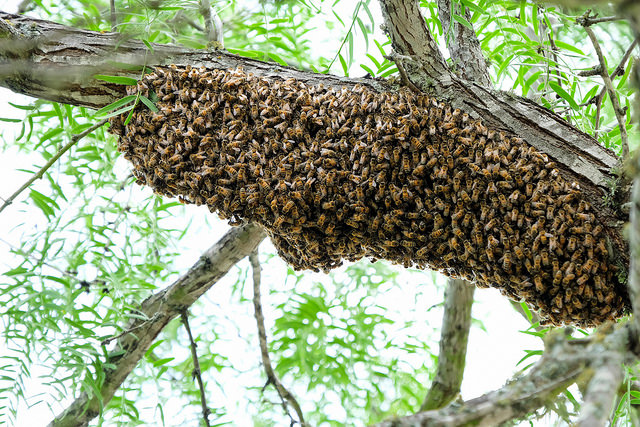For the most part, humans have a peaceful coexistence with bees. We let them do their thing, we take their delicious honey, and everyone is happy – those with bee allergies avoid them altogether. But sometimes bees act in strange ways, and it’s hard to tell whether or not you should be concerned. Wizzie Brown, an insect specialist with the Texas A&M AgriLife Extension Office, is here to explain the difference between a swarm and a colony, and what you should do if you encounter either one.
Swarms look dangerous – what are all those bees doing anyway?
“Swarming is a natural procedure of a colony. It’s basically the queen and half the workers, (they) leave the colony and they’re going to look for a new home. It’s perfectly normal – this typically happens in the spring, sometimes it will happen in the fall. They do not have brood, which are the eggs – the larvae and the pupae – they do not have honey, they do not have wax, so basically they don’t have anything to defend when they are in a swarm. They are out looking for a new home.”
They are all hanging out on my mailbox, what do I do?
“It tends to freak people out because there’s this giant clump of bees on a tree branch or a mailbox or a fence post…it can be rather startling to see. They’re going to be pretty docile unless you come and do something crazy to disturb them. Typically a swarm will move on of its own accord within a few hours to a few days. But you don’t need to spray it with a hose or anything like that, just let it do its thing. If you want, you can call a beekeeper and see if they want to collect the swarm.”
Okay, so what is a colony?
A colony is when a bee is actually in its home…they have their young – the larvae and the pupa – they have honey that they are creating, they have wax. They will defend their hive. Colonies are something that you would need to be concerned about. Bees can create colonies in locations that we don’t necessarily want them, like the wall weight of a house. If that’s the case, then you would need to contact someone to come out and get rid of those bees for you. That can either be a beekeeper that relocates them, or you can contact an exterminator or a pest control company.”
I had the colony relocated, now what?
“If you have a colony in the wall weight of your house, you do need to make sure after all the bees are gone – regardless of how they were moved – that you open that wall up and you take the honey and wax out or you can run into secondary problems like cockroaches, wax moths, mice, and all sorts of things.”
















